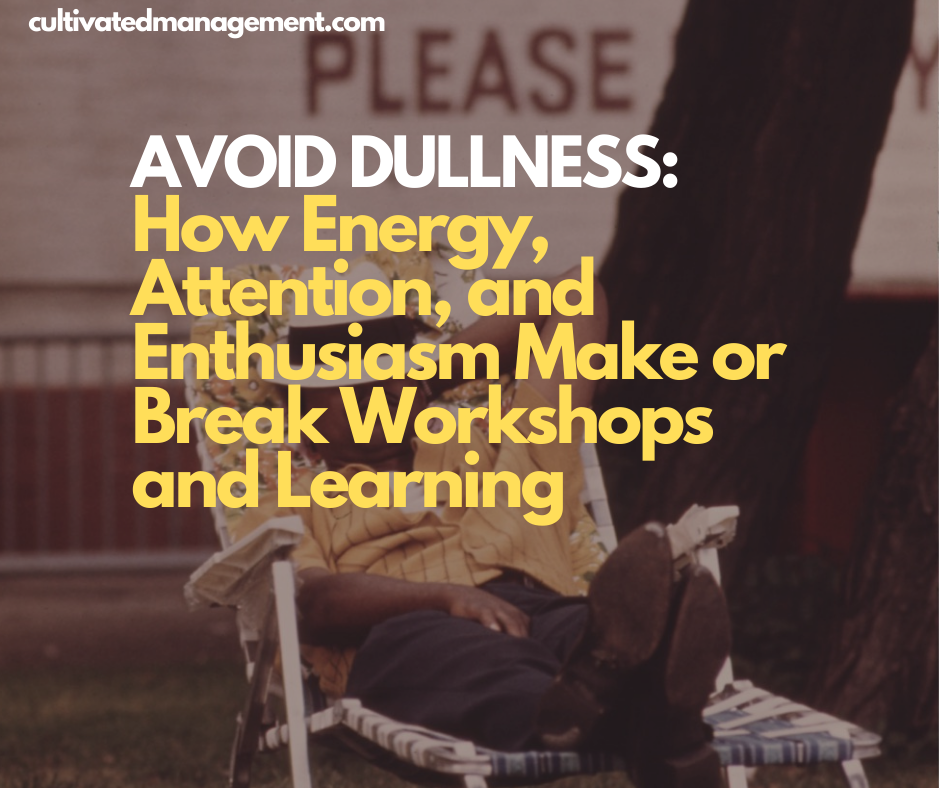Avoid Dullness: How Energy, Attention, and Enthusiasm Make or Break Workshops and Learning
Workshops succeed or fail on energy, attention, and enthusiasm. Content alone isn’t enough—without engagement, learning stalls. Discover why avoiding dullness is the key to keeping people interested, inspired, and ready to learn in any workshop or teaching environment.

Avoid Dullness
I’d just wrapped up a half-day version of my Communication Workshop at a conference. By the afternoon, I thought I’d switch roles and become a student again. There was a workshop on a topic that was very popular at this conference, and the room was packed. I grabbed my Moleskine, slid into a chair, and got ready to take notes.
Now, I was tired.
Anyone who’s run a workshop knows the feeling: the 15k – 20k steps, the energy, the preparation, the questions, the focus. It’s exhilarating and fun, but it drains you too. So at first I thought the low energy in the room was just me.
But as time went on, I noticed something. People started to leave. One by one, then table by table. What had started as a buzzing, full session slowly emptied out. The teacher, on clearly seeing the emptying of the room, did nothing to adjust their teaching style, approach or energy.
I felt for the person teaching. So I stayed longer than most. But after another half hour, I slipped out too. Life’s too short to sit through something that isn’t working.
By the break, I was sitting outside, scribbling notes for my Workshop Mastery book. When attendees filed out for coffee, very few went back in for the second half – why would they when it was clear the teaching approach wasn't going to change? Out of more than seventy who had started, only five remained by the end.
This is not unusual and quite common.
Every time I run a workshop at a conference I gain more students throughout the day. Their colleagues who are in my session invite them in, or they chat during the break and need a change of workshops, or they’re just flitting between them. I have only ever lost one student - and I asked him to leave (more in the book on that story).
What makes the difference? Attention.
And nothing kills attention like dullness.
Dullness
When you’re teaching, you’re not just transferring information on the subject — you’re keeping people’s attention long enough for that information to matter, to settle, to land.
The information itself must be worth knowing, but equally, the way you deliver it has to be interesting. Otherwise, the thread snaps, the points don't form a logical sequence, the dots between the content are not connected. People tune out.
Without attention there can be no learning.
The best workshop teachers have a whole toolkit to draw from: stories, questions, exercises, examples, activities, teaching methods. They prepare a solid plan that aims to avoid dullness before they've even started, but they also adapt on the fly. They can spot when the energy dips and they know how to bring it back.
Because energy is contagious. Enthusiasm spreads. And so does dullness.
Later that evening, I caught up with the workshop leader. They admitted they were disappointed. The workshop teacher said the content was solid, accurate, useful. And it may well have been. But without passion or spark, even good material won't land. Dullness has a way of turning people away, even from solid information.
It’s always a shame — for the teacher, and for the attendees. Students will try to carry the energy themselves if the topic really matters to them, but there’s only so much they can do. If the person at the front of the room is bringing dullness, the whole thing falls flat.
That’s why I design my workshops with dullness in mind — not to include it, but to avoid it. From the ground up, I think about how to weave in variety, activities, and interaction so the energy can’t dip too low.
On the day itself, I bring as much momentum, cheerfulness, and positive spirit as I can muster.
Because once attention is gone, learning is gone.
And if we’re in the business of teaching, that’s the one thing we can’t afford to lose.
If you want practical, insightful advice on avoiding dullness, designing engaging learning experiences, and keeping students at the heart of your workshops, my book Workshop Mastery can help.
👉 Workshop Mastery is your essential guide to designing and running engaging workshops that inspire lasting impact. Packed with proven facilitation techniques, practical strategies, and real-world insights.